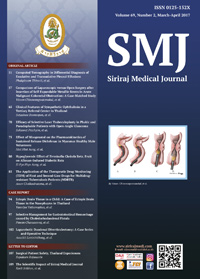Laparobotic Duodenal Diverticulectomy: A Case Series and Operative Technique
Keywords:
Duodenal diverticulum, duodenal diverticulectomy, robotic surgery, laparobotic duodenal diverticulectomyAbstract
Objective: Duodenal diverticulum is not uncommon but most are asymptomatic. Surgery is recommended only for the patients with symptoms. Although laparoscopic diverticulectomy can be done, it is often with significant difficulties due to inherent limitations of the laparoscopic technique and posterior location of the lesion. The advent of the robotic surgical technology with superior imaging and instrumentation may provide an alternative minimally invasive approach for this situation. We herein report our case series utilizing the daVinci Surgical System (dVSS) for duodenal diverticulectomy.
Methods: We retrospectively reviewed our robotic database for all duodenal procedures performed at a single institution (the Valley Hospital: VH). Only patients who underwent laparobotic duodenal diverticulectomy (LRDD) were included and their recorded videos reviewed. Data analyzed were patients’ demographic, perioperative outcomes, and technical details. We used the daVinci Si (Intuitive Surgical Inc. Sunny Vale, Calif.) for all cases.
Results: 4 female patients underwent LRDD. All presented with abdominal pain. Diagnosis was made by CT scans or MRI with or without EGD. 3 patients had diverticula located in the second part of the duodenum (75%). Concomitant procedures (choledochoduodenostomy and CBD exploration) were performed in two patients. Mean operative time was 142.5 min. There was one complication but no mortality. Average length of stay was 4 days.
Conclusion: LRDD is feasible, efficient, and safe. The dVSS provides the surgeon improved visualization and enhanced dexterity to perform complex procedure.
Downloads
Published
How to Cite
Issue
Section
License
Authors who publish with this journal agree to the following conditions:
Copyright Transfer
In submitting a manuscript, the authors acknowledge that the work will become the copyrighted property of Siriraj Medical Journal upon publication.
License
Articles are licensed under a Creative Commons Attribution-NonCommercial-NoDerivatives 4.0 International License (CC BY-NC-ND 4.0). This license allows for the sharing of the work for non-commercial purposes with proper attribution to the authors and the journal. However, it does not permit modifications or the creation of derivative works.
Sharing and Access
Authors are encouraged to share their article on their personal or institutional websites and through other non-commercial platforms. Doing so can increase readership and citations.











